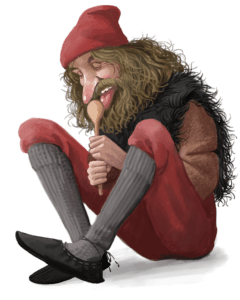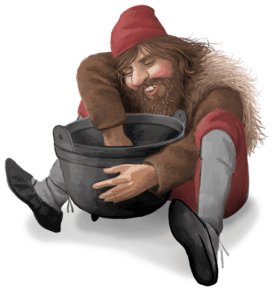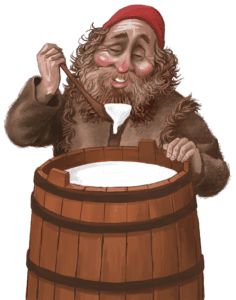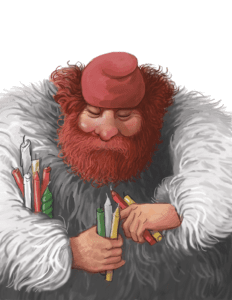Icelandic Christmas
Christmas in Iceland is a magical time full of activities for the whole family. Here we cover Icelandic Christmas traditions like Christmas markets, leaf bread and the 13 Yule Lads which make Icelandic Christmas so unique. You can also read about what Icelanders like to eat during the holidays and get information on opening hours and public transport.
Christmas Folklore
Yule Lads
Iceland’s vast folklore adds to the mystique and thrill of the Christmas Season with no less than 13 mischievous Yule Lads, or “jólasveinar”, who are supposed to be descendants of trolls. They live in the mountains with their terrifying ogress mother Gryla and her giant black cat, which eats all the children who don’t receive new clothes for Christmas.
Instead of bringing gifts, the Yule Lads take turns sneaking into town during the 13 days before Christmas to create mischief as Icelandic families prepare for the holiday festivities. During this time ‘Window Peeper’, ‘Bowl Licker’, ‘Door Slammer’ and their 10 brothers do just what their names suggest.
But these playful lads aren’t all bad, they often make appearances at holiday gatherings to sing and dance around the Christmas tree, and they do leave a small present in the shoes of children who leave them on windowsills for that purpose.
After Christmas, the Yule Lads head back to the mountains one at a time until they’ve all gone.
Which Yule Lad are you?
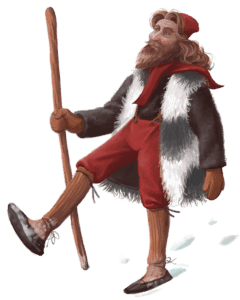
Sheep-Cote Clod / Stekkjastaur
The first Yule Lad, Sheep-Cote Clod, comes to town on December 12th.
He used to try to suckle the yews in the farmers’ sheep sheds, which was hard for him since his legs are stiff as wood.
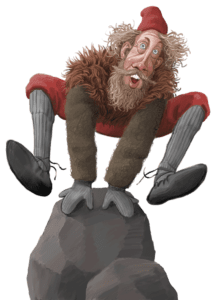
Gully Gawk / Giljagaur
Next in line is Gully Gawk.
He waits in gullies for a chance to sneak into the cowshed to slurp the foam off the fresh milk when the milkmaid looks away.
Stubby / Stúfur
Stubby arrives on December 14th.
The smallest of his brothers, Stubby uses his vertically challenged stature to hide and snatch bits of food from the frying pan. That’s why he’s also known as Pan Scraper.
Spoon Licker / Þvörusleikir
On December 15th it is Spoon Licker’s turn.
He likes to sneak into houses and lick the wooden spoon used to scrape the pots. Unfortunately, this poor diet has led to malnutrition and his very gaunt appearance.
Pot Scraper / Pottasleikir
Pot Scraper comes to town on 16 December.
He likes to knock on your door and when you go to answer it, he snatches away the pots that have not been washed and licks the food remains from the insides.

Bowl Licker / Askasleikir
Up next is Bowl Licker.
In the past, Icelanders ate from lidded wooden bowls that they sometimes kept under the bed or on the floor. Bowl Licker would hide under the bed, and if someone put their bowl on the floor he grabbed it and licked it clean.
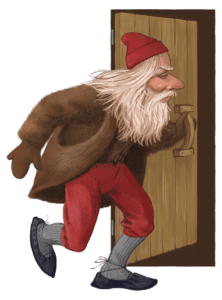
Door Slammer / Hurðaskellir
On December 18th there’s no more peace and quiet since that’s when Door Slammer arrives.
He likes to make a lot of noise and his favorite is slamming doors, making sure no one gets any rest.
Skyr Gobbler / Skyrgámur
Skyr Gobbler makes his way down from the mountains on the 19th.
He is obsessed with skyr, an Icelandic dairy product similar to yogurt. He likes it so much that he’ll sneak into the pantry and eat all the skyr until he howls with indigestion.
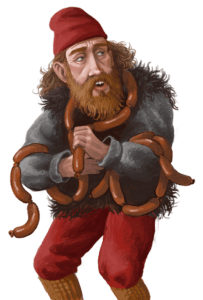
Sausage Swiper / Bjúgnakrækir
December 20th marks the appearance of Sausage Swiper.
He loves to eat sausages and will sit up in your rafters waiting for an opportunity to steal them.
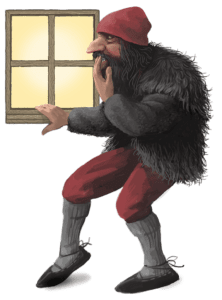
Window Peeper / Gluggagægir
December 21st is when Window Peeper visits.
While not as greedy as some of his brothers, Window Peeper can still give you a fright. He likes to peep through the windows in search of something to steal.
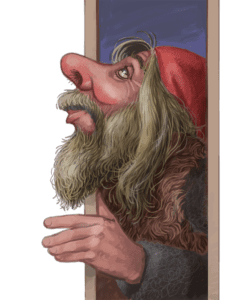
Door Sniffer / Gáttaþefur
Door Sniffer comes to town on December 22nd.
You can spot him from miles away due to his huge nose. The smell of Christmas cookies and leaf bread is what attracts him to your doorway and if you look away he will attempt to steal some.
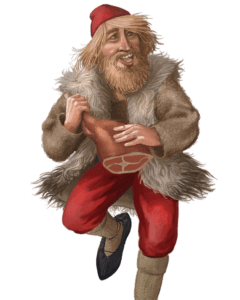
Meat Hook / Kjetkrókur
Second to last, Meat Hook arrives on December 23rd, or St. Thorlaks Mass.
Meat Hook is crazy about meat. He’ll climb up to your roof and lower a long hook through the chimney to try and snag a smoked leg of lamb hanging from the rafters, or a piece of smoked lamb from the pot.
Candle Beggar / Kertasníkir
The last of the brothers is Candle Beggar who arrives on Christmas Eve, 24 December.
In the old days, candles were the brightest lights available to people in Iceland and were made of tallow. All children longed to have their very own candle for Christmas. Candle Beggar just wants a candle of his own to take a bite out of.

Christmas stories
Elves on Christmas Night
Every Christmas Eve when the inhabitants of a small farm in Eyjafjörður left to go to church, they would come back to find that the person left behind to mind the farm had either been killed or driven mad.
One year as they headed off for church, a young woman was the one left behind. Once the people had gone, she sat down by her bed and started to read a book by candlelight.
After sitting for a while she noticed three children playing in the room. Their play increased in intensity as they moved up towards her bed and finally started playing with the young woman. She‘d pretended like she didn‘t notice them but now she was tender with them and patted their hands. They then started grabbing her candle so she took it and divided it evenly into four parts, lit one for each child and kept one for herself. This made the children very happy and they ran off with their little lights.
After a moment a man entered and sat next to the young woman. He was sweet towards her but she pretended not to see him. This made him more eager in his affections.
At this she turned serious and told him his attempts were of no use “since I will pay your affections no mind”
He stopped and left. After a moment a woman in blue entered. She was carrying a wooden chest and as she walked towards the young woman she said:
“I don‘t have much with which to pay you for your kindness towards my children, and your unkindness towards my husband, but I want you to have the clothes that are in this chest. But don‘t tell anyone where you got them until after Christmas next.”
She handed the chest to the young woman and left. When the people of the farm returned from church they were happy to see that the young woman was alright, but she wouldn‘t tell them what had transpired that night. Time passed until it was summer.
One day the young woman laid her clothes from the chest out to dry. When the farmer‘s wife saw the clothes she was consumed with jealousy and asked the young woman where she‘d gotten them. The young woman said it was none of her business and the farmer‘s wife guessed she‘d gotten them last Christmas.
Next Christmas as the farm people were getting ready to go to church, the farmer‘s wife said she would stay and mind the farm. The farmer was not happy with this but she persisted.
So everyone on the farm left for church, leaving the farmer‘s wife at home. She sat by her bed and read by candlelight. Three children appeared in the room and started playing. Their play increased in intensity as they moved up towards her bed and finally started playing with the farmer‘s wife. She grew angry and shouted at them but they kept on and started grabbing the candle. At this, the farmer‘s wife grabbed a broom and beat the children who ran off crying.
After a moment a man entered and sat down next to the farmer‘s wife. He was sweet towards her and she responded in kind. She gave him everything he wanted and after they‘d both been satisfied the man left. Then a woman entered, walked up to the farmer’s wife, took her hand and said:
“Is this the hand with which you beat my children and stroked my husband? “
The other woman was unable to deny it.
The strange woman then said “May this hand wizen until it kills you. That is the price for your evil deeds.“
She left and the farmer‘s wife waited for the rest of the house to arrive home from church. By that time she was feeling ill and her hand was limp. She told them what had happened that night. The young woman then told them what had happened to her the Christmas before and showed them her clothes. They were much admired and everyone agreed they had never seen such fine clothes before. She enjoyed the clothes for many years after but the farmer‘s wife became increasingly ill until she died.
The Elves of Drangey
Once there was a prosperous farmer who lived at Höfði on Höfðaströnd. He and his wife had no children, but he fostered a young boy, whom he loved very much and who was very well liked by everyone.
On Christmas Eve when the boy was 14 years old, someone needed to be sent to get sheep to Drangey, for the Christmas meal. The boy begged his foster father to allow him to go out to the island to get the sheep. The farmer was reluctant to let him go but finally relented if the farmhands would let him go with them.
The journey went well and they managed to herd the sheep and get them on board the boat. Before they could leave though, the farmhands said they had left their gloves on the island.
The boy offered to run and get them. As he ran the farmhands pushed the boat out, stranding the boy on the island. He watched them go with tears in his eyes. Suddenly a snowstorm hit and the boy thought he would die on the island from cold and starvation.
To avoid the raging waves on the beach the boy headed inland to look for shelter. After a while, he came to a shed built to give the roaming sheep shelter. The boy went in and covered himself in straw for warmth.
At dawn, he hears loud noises outside the shed. Then he hears several people walk in and put down tables for food and drink. He thinks to himself that these must be good people and they might be willing to give him a bite if he comes forward. He jumps up and sees tables loaded with delicious dishes and people of all ages eating. But once they see him the people all disappear, leaving the food. The boy stayed in the shed until New Year’s Day, and never once went hungry.
Back on the mainland, the farmhands had barely made it back unscathed, but no one realized the boy was missing until Christmas morning when they went to sing hymns. The farmer asks whether the boy is not going to join him in song. At this, the farmhands wake from a seeming sleep and confess that they had forgotten him, as he had not been near when they sailed off the island.
The farmer is angered and curses them, but nothing could be done. The storm didn’t let up until New Year’s Day when the farmer could finally head out to Drangey himself. Once he gets there is no one to be seen. He feels sure that the boy is dead but still walks up to the shed.
The boy hears his foster father’s voice and picks up a silver chalice to take outside to show him. The farmer is happy to see him and the boy tells his father the whole story. After that, they go into the shed but the shed is now completely empty, leaving only the silver chalice the boy had in his hand when he stepped outside.

Christmas Traditions
Icelanders are big fans of Christmas traditions, Christmas concert, Christmas Buffets, Christmas parties, Christmas walks and the Christmas books – all these things are a must in December.
Þorláksmessa
Þorláksmessa (Thorlaksmessa) is on the 23rd of December. It is a celebration in honor of Þorlákur Þórhallson, the bishop of Skálholt (1133-1193) and the patron saint of Iceland. In modern times, however, this day has become a part of Iceland’s Christmas tradition. On this day, people finish decorating their homes and put up their Christmas trees. This is also the busiest shopping day of the year, people flock to the shopping malls and to Laugavegur, the main shopping street downtown, to finish their Christmas shopping and/or just to get into the Christmas spirit. A jolly holiday stroll down Laugavegur is a must for so many-either as a part of the Peace Walk (to raise awareness of the fight for world peace) or just to see and be seen!
Christmas Eve
Icelanders celebrate Christmas on Christmas Eve. During the day, many deliver Christmas presents to their loved ones, go to light candles in cemeteries, maybe take a dip into a swimming pool or just enjoy the day and look forward to the festivities in the evening. At 18:00 (6 pm) the church bells ring and Christmas begins. Some people go to mass at 18:00 but other sit down at the dinner table for their much-anticipated Christmas dinner and listen to the mass whilst eating. After dinner they (finally!) open their presents. Icelanders are big book readers and there are almost certainly a few books under each Christmas tree. In Iceland, we talk about the “Christmas book flood,” because there are so many new books published each year before Christmas. So, after the presents have been unwrapped, many like to cuddle up in their pajamas (preferably with a box of chocolate) and read their new Christmas book.

Traditional Food
Hangikjöt is the smoked lamb traditionally served by Icelanders over the Christmas holidays. The meat is usually served with potatoes in Béchamel sauce and green peas but there are several other imaginative ways to make a meal of this delicious local delicacy. Leftover Hangikjöt can be used on Icelandic flatbread, in sandwiches or as a tasty snack. Hangikjöt is usually boiled but each family will have its own opinion on how to boil it and for how long. Try it with the Christmas favorite Malt & Appelsín, a mix of two soft drinks that has become traditional.
Baking is a big part of Christmas preparations in Iceland. Most homes will bake several different kinds of Christmas cookies and most families will have had traditional recipes handed down through generations and will guard them heavily. What most Icelanders find absolutely essential to Christmas is the Leaf Bread. Ingredients to make the wafer thin bread were hard to find most times of the year except around Christmas and the bread was baked so thin so everyone could have a piece. Decorative patterns are carved into the bread to make it more festive.
Skate is a fish closely related to the species of rays. Skate is considered a delicacy in Iceland and is served on Thorlak’s Mass on December 23rd. Similarly to how Icelanders process shark, the skate is putrefied and therefore has a very strong smell. On Thorlak’s Mass wherever you are, you are sure to run into the smell before you hear the noise of Icelander’s making merry. Skate is usually served with boiled potatoes and rye bread. Read more in our blog.
Many households will serve ptarmigan on Christmas Eve. Ptarmigan is a bird in the grouse family and has a similarly gamey taste. Like with the Hangikjöt, each family will have their own way of preparing and serving the ptarmigan. However, most people will serve it with caramelized potatoes and pickled red cabbage. In the olden days ptarmigan was eaten in poorer households, ones that couldn’t afford a lamb, but today the dish has become very popular and sometimes the meat is even sold out in shops.
Risalamande
A tradition that originates in Denmark, the cold rice pudding known as risalamande has become a crucial part of the Christmas meal for many Icelanders. Rice is boiled in milk and vanilla and after it has cooled, cream and almonds are mixed in. It is then served as a dessert on Christmas Eve with either cherry- or applesauce. Many families will play a game where a whole almond is hidden in the pudding and the one who finds it wins a small prize.
Christmas recipes
Christmas time in Iceland is full of local traditions. The baking of Christmas cookies is an important part of the advent and most families will bake several different kinds of cookies to last through Christmas. Take part in this old custom and bake Icelandic cookies in your own home.
Stella’s ginger cookies
This family recipe comes from one of the Iceland Travel team members.
500 gr Flour
400 gr Brown sugar
225 gr Butter
2 Eggs
1 tsp Baking soda
2 tsp Cinnamon
2 tsp Ginger
1 tsp Cloves
1 tsp Baking powder
Cut the butter into small pieces (at room temperature) and mix all ingredients together.
Make small balls and press them down with a fork.
Bake for 15 minutes at 190°C

Christmas Markets
Ice Skating & Yule Town at Ingolfstorg
Nova, in cooperation with Samsung and Reykjavik City, annually open up an ice-skating rink at Ingolfstorg Square the 1st of December.
A Christmas village decorated with lights is next to the rink where you can enjoy food, drinks and other goods while getting into the Christmas spirit.
The rink will remain open daily from midday to 22:00 until 24th of December.
Admission is free. Skates and helmets are rented out for 990 ISK per hour.
The Heidmork Christmas Market
The annual Crafts & Design Christmas market and the Christmas tree sale in Heidmork woods, located on the outskirts of Reykjavík, will be open every weekend from the 30th of November until the 17th of December, from 12:00 – 17:00.
With readings and concerts at the cafeteria every day, there is plenty to see at this market that mainly sells hand-crafted items. Every day at 14:00 a small bonfire is lit and Christmas stories are read for the children. One of the Yule Lads might even pop in for a visit.
The Christmas Village in Hafnarfjordur
The whole downtown area of Hafnarfjordur becomes one big Christmas Village during Advent.
The Christmas Village is very kid friendly as the local children are in charge of decorating and the local primary school provides entertainment. Various competitions are held, like a competition for the best snowman. Adults can enjoy perusing the various stalls selling hand-crafted items, street food or warming drinks.
The Christmas village is open every Saturday and Sunday from 13:00-18:00 during Advent.

Opening hours
On Christmas Eve, most businesses close early, from noon till 14:00. This is also the case on New Year‘s Eve.
Most shops, restaurants, bars, museums, and other attractions are closed on Christmas Day (December 25.), Boxing Day (December 26.) and New Year‘s Day (January 1.).
Here you will find a list for opening hours of popular restaurants and museums https://visitreykjavik.is/opening-hours
Public Transport
Updated information and a trip planner can be found on Straeto’s (the public bus system) website.
24 December: Regular schedule until c.a. 15:00 (3 pm)
25 December: Sunday Schedule
26 December: Sunday Schedule
31 December: Regular schedule until c.a. 15:00 (3 pm)
1 January: Sunday Schedule
The Blue Lagoon
24 December 8:00 – 15:00
25-31 December: Regular Opening Hours

